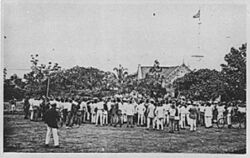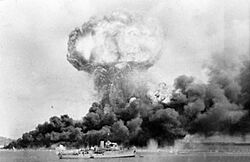History of Darwin facts for kids
The history of Darwin tells the story of how this important city in Australia's Northern Territory grew from a small settlement into a busy capital.
Contents
Early Days
Long before Europeans arrived, the Larrakia people lived in the Darwin area. They were skilled traders, exchanging goods with people from Southeast Asia and even as far away as South Australia and Western Australia. They used special songlines to share stories and history across the land.
In the 1600s, Dutch explorers sailed along Australia's northern coast. They created the first European maps of the area, which is why some places still have Dutch names, like Arnhem Land and Groote Eylandt (meaning "large island").
The 1800s
In 1839, Lieutenant John Lort Stokes from the ship HMS Beagle was the first British person to see Darwin harbour. The ship's captain, Commander John Clements Wickham, named the port after the famous English naturalist Charles Darwin.
It wasn't until 1869 that a lasting European settlement was built. The South Australian Government, which controlled the Northern Territory at the time, sent George Goyder to set it up. On February 5, 1869, Goyder started a small town of 135 people at Port Darwin. He named it Palmerston after the British Prime Minister, Lord Palmerston.
In the 1870s, a huge Australian Overland Telegraph Line was built, stretching 3,200 kilometres (2,000 mi) from Port Augusta to Darwin. This line connected Australia to the rest of the world! During its construction, workers found gold near Pine Creek, about 200 kilometres (120 mi) south of Darwin. This discovery helped the young settlement grow even faster.
In February 1875, a ship called the SS Gothenburg left Darwin for Adelaide. Sadly, it sank in a storm off the Queensland coast, and about 102 people lost their lives. Many of them were Darwin residents, and the tragedy deeply affected the town.
The Fannie Bay Gaol (a prison) was built between 1882 and 1883.
From the 1870s, many Chinese settlers came to the Northern Territory, especially to work in the goldfields and on the railway. By 1888, there were over 6,000 Chinese people in the area, mostly in Darwin. Later, due to new government rules that made it harder for non-Europeans to live in Australia, many Chinese people left. However, some families stayed, became Australian citizens, and helped build businesses in Darwin.
In 1884, the pearling industry brought people from Japan, Timor, and the Philippines to Darwin. Many of their families are still important parts of Darwin today.
In 1897, a powerful cyclone completely destroyed the settlement, killing 28 people.
-
The wreck of the SS Gothenburg.
The 1900s
| Historical Populations of Darwin | ||
|---|---|---|
| Year | Pop. | ±% |
| 1911 | 1,082 | — |
| 1921 | 1,399 | +29.3% |
| 1933 | 1,566 | +11.9% |
| 1947 | 2,538 | +62.1% |
| 1954 | 8,071 | +218.0% |
| 1961 | 15,477 | +91.8% |
| 1966 | 21,671 | +40.0% |
| 1971 | 37,100 | +71.2% |
| 1976 | 44,200 | +19.1% |
| 1981 | 61,412 | +38.9% |
| 1986 | 75,360 | +22.7% |
| 1991 | 86,415 | +14.7% |
| 1996 | 95,829 | +10.9% |
| 2001 | 106,842 | +11.5% |
| 2006 | 105,991 | −0.8% |
| 2009 | 124,800 | +17.7% |
| 2010 | 127,829 | +2.4% |
| 2011 | 129,106 | +1.0% |
| 2012 | 132,321 | +2.5% |
| 2013 | 137,353 | +3.8% |
| 2014 | 140,386 | +2.2% |
In 1911, the city's name officially changed from Palmerston to Darwin. The Northern Territory had been managed by South Australia, but in 1911, it became part of the Commonwealth of Australia.
The Darwin Rebellion
On December 17, 1918, a protest known as the Darwin Rebellion took place. Members of the Australian Workers' Union, led by Harold Nelson, protested against the Administrator of the Northern Territory, John A. Gilruth. They even burned a dummy (an effigy) of him and demanded he resign.
Bombing of Darwin
During World War II, on February 19, 1942, at 9:57 am, 188 Japanese warplanes attacked Darwin in two waves. This was the same fleet that had bombed Pearl Harbor. Even though Darwin was a smaller target, more bombs were dropped on Darwin than on Pearl Harbor.
The attack killed at least 243 people and caused huge damage to the town. These were the most serious attacks on Australia during the war, in terms of lives lost and damage. Darwin was attacked by air 58 more times in 1942 and 1943, but the first raids were the most devastating.
This event is often called the "Pearl Harbor of Australia" because, like Pearl Harbor, the town was not fully prepared for such a large attack.
Darwin officially became a city on Australia Day (January 26) in 1959.
Cyclone Tracy
On Christmas Day, December 25, 1974, Darwin was hit by Cyclone Tracy. This terrible storm killed 71 people and destroyed over 70% of the town's buildings. Many old stone buildings, like the Palmerston Town Hall, couldn't stand up to the incredibly strong winds.
It was Australia's worst natural disaster. Winds were estimated to be up to 250 kilometres per hour (160 mph). The total damage cost was $1 billion. Sixteen people were lost at sea and their bodies were never found.
After the disaster, about 30,000 people were evacuated from Darwin by air and ground. This was the biggest airlift in Australia's history. Women, children, the elderly, and the sick were evacuated first. By December 31, only about 10,900 people, mostly men who stayed to help clean up, remained in Darwin.
After the 1970s
After Cyclone Tracy, Darwin was rebuilt in the late 1970s using new materials and building methods. All new buildings had to follow strict rules to withstand cyclones. Steel became a popular building material, leading to a unique modern style in Darwin called Troppo. You can also see influences from Southeast Asian architecture in some buildings.
In the early 1980s, a new town called Palmerston was built about 20 kilometres (12 mi) south of Darwin.
Because of the air raids and cyclones, Darwin doesn't have many very old buildings. However, some of the stronger stone structures survived and have been repaired. With more people moving to Darwin, there has been a boom in tall apartment buildings, especially in the city center and along the coast.
More to Explore
- Timeline of Darwin History
- History of the Northern Territory
- Aviation history of Darwin








